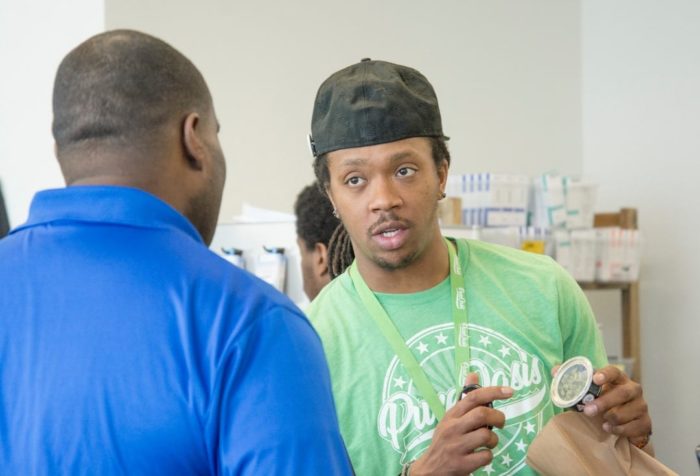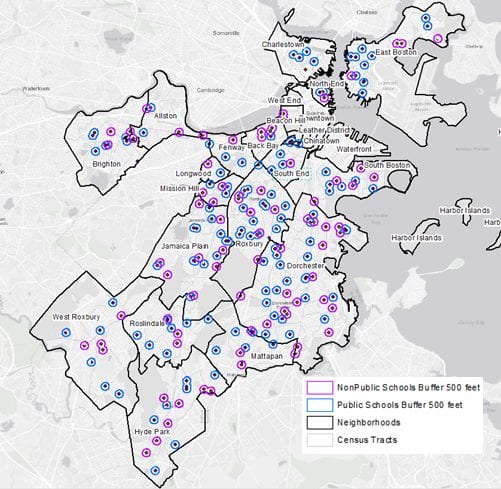
“We have to do everything that we can to dismantle this pipeline to prison that continues to criminalize Black and brown people.”
Creating drug-free school buffer zones sounds like a good idea. However, the consequences and disparate impacts of these zones, complete with the high-stakes mandatory-minimum sentences that accompany them, have led to the mass incarceration of thousands of Black and brown residents.
Now, this same failed policy is being used to prevent communities of color from opening cannabis retail shops in their own neighborhoods—denying the very same economic opportunities marijuana legalization was designed to create.
As a former Suffolk County prosecutor, I can speak first-hand to the impacts that school zones have had on families. The perverse justification of “think of our (white) kids” provided cover for law enforcement to heavily punish and incarcerate predominately Black and brown kids who lived and were caught within these “sentencing enhancement zones.” In densely populated urban areas, smoking a joint on your “school-zoned” tenement stoop led to possession, arrest, conviction, and mandatory-minimum sentences. Meanwhile, smoking a joint on your front porch in a leafy suburb was just “kids being kids.”
Same behavior; disparate impact.
While Boston’s school zones have been largely reformed and eliminated, “sensitive use” buffers continue to materially block Black and brown people from opportunities to create generational wealth in Boston’s new cannabis industry. From the failed war on drugs and the resulting prisons filled with our youth, we have seen the profoundly disparate human and societal toll of school buffer zones—zones that our communities of color overwhelmingly fall within.
Speaking at the signing of Boston’s new cannabis ordinance, City Council President Kim Janey said, “We have to do everything that we can to dismantle this pipeline to prison that continues to criminalize Black and brown people.”
Amen. Today, Boston prohibits even the submission of an adult-use application located within 500 feet of a public or private school serving grades K-12 under the false pretense that the prohibition is a requirement of state law.
This is false. Boston does have a choice, and the City Council has an obligation to support communities of color by creating buffers that work for all residents. State law allows Boston to reduce buffers by ordinance or by-law, while the Cannabis Control Commission has itself acknowledged that overly strict zoning rules and large buffer zones sharply limit the number of parcels available to potential operators, favoring large corporations with substantial financial resources while disproportionately harming smaller, local companies.

Reinstating school buffer zones will reduce viable adult-use sites and significantly raise costs (and the stakes) for Black and brown entrepreneurs. Today, liquor stores are often located in “school zones.” Why should cannabis be treated any differently? Just like liquor stores and bars, the City Council should ensure communities of color have a choice as to which cannabis companies should operate in our neighborhoods.
Communities like Cambridge and Somerville have already successfully reduced school buffers to 300 feet, recognizing the restorative justice intended by cannabis legalization and how these overly restrictive buffers run counter to those goals.
Like in Cambridge and Somerville, the Boston City Council also has a choice: to choose to respect the self-determination of communities of color and recognize that we, as people of color, are able to advocate and choose for ourselves.
As a Black woman, I have been proud to stand shoulder-to-shoulder with so many of our residents as the Black Lives Matter movement has swelled to become the single largest organized protest in modern history. While protests can inspire, our policy choices make them meaningful. The Boston City Council has the opportunity to do just this; by acknowledging the failure of school buffer zones that shackled our communities.
Opportunities to create generational wealth have eluded communities of color. The economic opportunity a vibrant cannabis industry can provide to our Black and Brown residents will not be taken from us this time.
Because of Mayor Walsh and Councilor Janey, we can celebrate locally and nationally the symbolism of the cannabis ordinance’s passage. However, without further urgent action by the City Council, this ordinance will be a symbol of an unfulfilled promise, rather than a symbol of true restorative justice.
Linda Champion is a Black Korean American attorney and former Suffolk County prosecutor. She serves as an Advisor to the President of Whittier Street Health Center, Board Vice-Chair to CUE Realty, a wholly owned subsidiary of Urban Edge and an Advisor to Boston Showstoppers.

